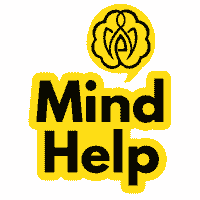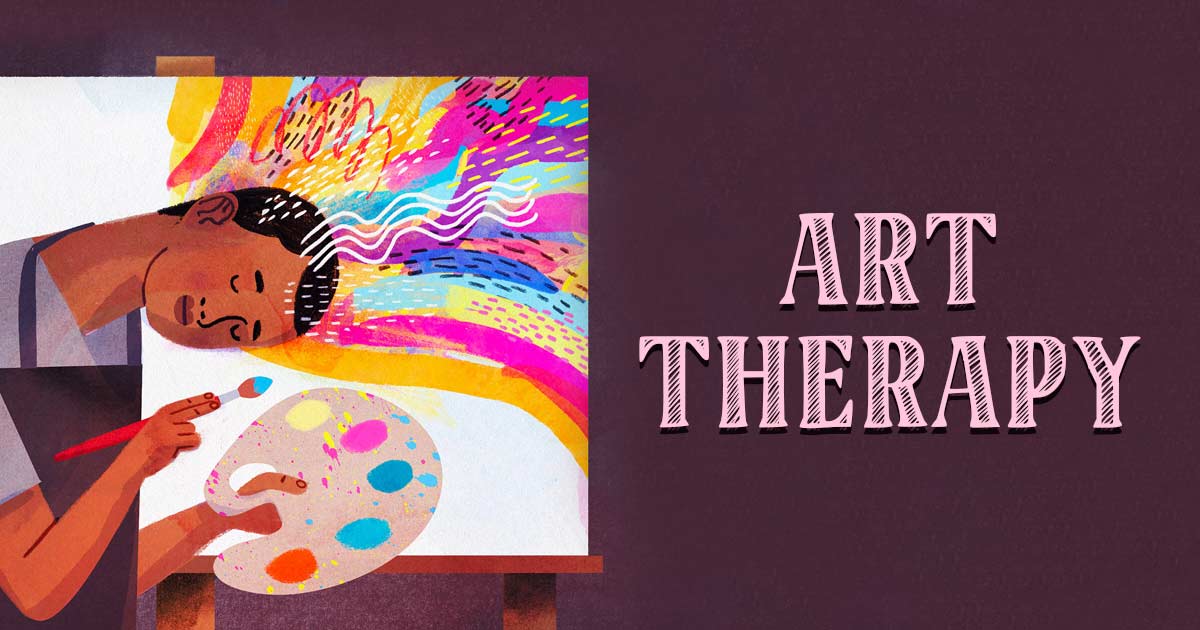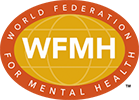Art therapy is a form of therapy that utilizes the creative process of making art to improve mental, emotional, and physical well-being. It can be used to explore and express feelings, increase self-awareness, and promote personal growth and healing.
What is Art Therapy?
Art therapy is a powerful tool that leverages creative expression 1 Iguina, M. M., & Sanaz Kashan. (2019, November 6). Art Therapy. Nih.gov; StatPearls Publishing. Available from: https://www.ncbi.nlm.nih.gov/books/NBK549771/ to boost conflict resolution, problem-solving, social skills, and stress management. By utilizing an array of art materials and techniques, such as drawing, painting, sculpting, and collage, art therapy enables individuals to express their emotions and experiences in a secure space, fostering effective communication.
In fact, art therapy is the most commonly preferred option among the 43% of the general population 2 Millard, E., Medlicott, E., Cardona, J., Priebe, S., & Carr, C. (2021). Preferences for group arts therapies: a cross-sectional survey of mental health patients and the general population. BMJ open, 11(8), e051173. https://doi.org/10.1136/bmjopen-2021-051173 . Additionally, art therapy is particularly beneficial for individuals who find it challenging to articulate their feelings or have learning difficulties.
The term “art therapy” was first introduced by British artist Adrian Hill in 1942, who discovered the therapeutic benefits 3 Günter M. (1990). Gestaltungstherapie in der psychiatrischen Klinik. Eine historische Analyse der Entstehung von Malateliers [Art therapy in the psychiatric clinic. A historical analysis of the development of art studios]. Psychiatrische Praxis, 17(5), 163–171. of painting and drawing while recovering from tuberculosis. As a result, art therapy became an acknowledged therapeutic approach in the mid-20th century, emerging as a profession independently and simultaneously in both the United States and Europe.
Purpose of Art Therapy Interventions
The purpose of creative art therapy is to help individuals 4 Joschko, R., Roll, S., Willich, S. N., & Berghöfer, A. (2022). The effect of active visual art therapy on health outcomes: protocol of a systematic review of randomised controlled trials. Systematic reviews, 11(1), 96. https://doi.org/10.1186/s13643-022-01976-7 :
- To provide a safe and supportive environment for individuals to express themselves
- To help individuals explore and understand their thoughts, feelings, and experiences
- To promote emotional and psychological healing
- To encourage personal growth and development
- Gain new perspectives and problem-solve through artistic exploration
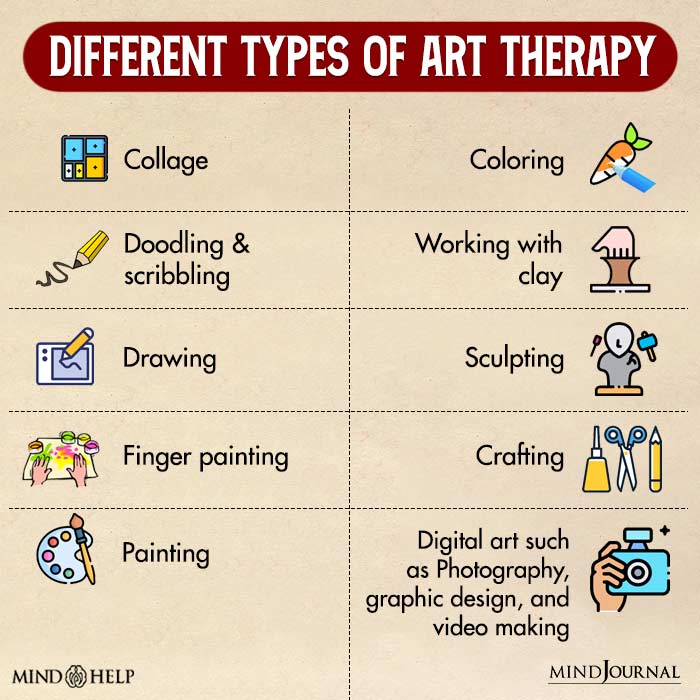
How Does Art Therapy Work
In the session of art therapy for mental health conditions, the therapist collaborates 5 Bitonte, R. A., & De Santo, M. (2014). Art Therapy: An Underutilized, yet Effective Tool. Mental illness, 6(1), 5354. https://doi.org/10.4081/mi.2014.5354 with the client to identify sources of distress and then helps clients create art to address these issues. The following are typical steps that an art therapist may take during a session:
- Clarify the purpose of art therapy and reassure clients that they do not need to have any prior artistic skills or experience to benefit from the process.
- Help clients choose an appropriate medium from different types of art therapy such as drawing, sculpture, collage, or painting to express themselves.
- Guide clients through the creative process by asking questions and providing suggestions as needed.
- Encourage clients to reflect on their artwork and the emotions that may arise from the process.
- Discuss the results of the session with the client, both in terms of the artwork itself and the client’s emotional response.
- Plan for future sessions or for the client to continue working on their own outside of therapy.
Art Therapy for Mental Health Disorders
Art therapy has the potential to address a variety of mental health 6 Hu, J., Zhang, J., Hu, L., Yu, H., & Xu, J. (2021). Art Therapy: A Complementary Treatment for Mental Disorders. Frontiers in psychology, 12, 686005. https://doi.org/10.3389/fpsyg.2021.686005 disorders and emotional distress, such as:
1. Anxiety Disorders
Engaging in creative art therapy can promote relaxation, mindfulness, and a sense of calm. This can help individuals to reduce the physical and emotional symptoms of anxiety.
Read More About Anxiety Disorder Here
2. Depression
Creating art can give individuals a sense of purpose and achievement, which can be particularly beneficial for those struggling with feelings of worthlessness or low self-esteem.
Read More About Depression Here
3. Post-Traumatic Stress Disorder
Art therapy can help individuals to understand and make sense of traumatic experiences 7 Maltz, B., Hoyt, T., Uomoto, J., & Herodes, M. (2020). A case analysis of service-member trauma processing related to art therapy within a military-intensive outpatient program. Journal of clinical psychology, 76(9), 1575–1590. https://doi.org/10.1002/jclp.22929 by creating art that explores their thoughts and feelings related to the experience. This can facilitate cognitive processing, which can lead to a better understanding and acceptance of the experience.
Read More About Post-Traumatic Stress Disorder Here
4. Substance Use Disorder
Art therapy can provide substantial benefits 8 Aletraris, L., Paino, M., Edmond, M. B., Roman, P. M., & Bride, B. E. (2014). The use of art and music therapy in substance abuse treatment programs. Journal of addictions nursing, 25(4), 190–196. https://doi.org/10.1097/JAN.0000000000000048 for individuals struggling with substance use disorders and addictions. These benefits may include overcoming resistance, using creativity as an outlet to express complex emotions, and developing a deeper understanding of the spiritual and creative aspects of addiction and life.
5. Schizophrenia
Art therapy can assist individuals with schizophrenia 9 Luo, X., Zhang, Z., Zheng, Z., Ye, Q., Wang, J., Wu, Q., & Huang, G. (2022). Art therapy as an adjuvant treatment for schizophrenia: A protocol for an updated systematic review and subgroup meta-analysis of randomized clinical trials following the PRISMA guidelines. Medicine, 101(40), e30935. https://doi.org/10.1097/MD.0000000000030935 in testing and understanding their perceptions of reality. Through creating art and reflecting on the process, individuals can explore and challenge their beliefs and delusions.
Read More About Schizophrenia Here
6. Bipolar Disorder
Creating art can serve as a mood stabilizer 10 Pardee, C. (n.d.). Art Therapy and Bipolar Disorder. Www.academia.edu. Retrieved May 3, 2023, from https://www.academia.edu/13387965/Art_Therapy_and_Bipolar_Disorder , helping individuals with bipolar disorder to manage their emotions and reduce the severity and frequency of mood swings.
Read More About Bipolar Disorder Here
Benefits of Art Therapy
Art therapy can be helpful for individuals 11 Shukla, A., Choudhari, S. G., Gaidhane, A. M., & Quazi Syed, Z. (2022). Role of Art Therapy in the Promotion of Mental Health: A Critical Review. Cureus, 14(8), e28026. https://doi.org/10.7759/cureus.28026 in the following ways:
- A powerful tool for those who struggle with verbal communication, providing them with a means of expressing themselves
- Develop and enhance their hand-eye coordination, fine and gross motor skills
- Art therapy is often conducted in a group setting that can help people connect with others with similar struggles and gain emotional insight
- It is a fun experience as it combines enjoyable activities with therapeutic benefits
- It promotes relaxation, reduce stress, and improve overall mental and emotional wellbeing
Limitations of Art Therapy
Here are some limitations 12 Uttley, L., Scope, A., Stevenson, M., Rawdin, A., Elizabeth Taylor Buck, Anthea Sutton, Stevens, J., Kaltenthaler, E., Dent-Brown, K., & Wood, C. (2015, March). The acceptability and relative benefits and potential harms of art therapy: qualitative systematic review. Nih.gov; NIHR Journals Library. Available from: https://www.ncbi.nlm.nih.gov/books/NBK279642/ of art therapy:
- Art therapy has some positive findings on its effectiveness 13 Cook, S. C., Schwartz, A. C., & Kaslow, N. J. (2017). Evidence-Based Psychotherapy: Advantages and Challenges. Neurotherapeutics : the journal of the American Society for Experimental NeuroTherapeutics, 14(3), 537–545. https://doi.org/10.1007/s13311-017-0549-4 , but the majority of research indicates it may not be as effective as other forms of psychotherapy
- The progress in art therapy may be slower as it involves less talking
- Art therapy may not provide immediate relief and usually takes weeks to months to produce positive effects
- Art therapy exercises may not be equally appealing to all, as some who don’t view themselves as creative may get resistant, despite not requiring a high artistic ability to be successful
- Individuals with severe mental illness or cognitive impairments may not be able to participate fully in the art-making process
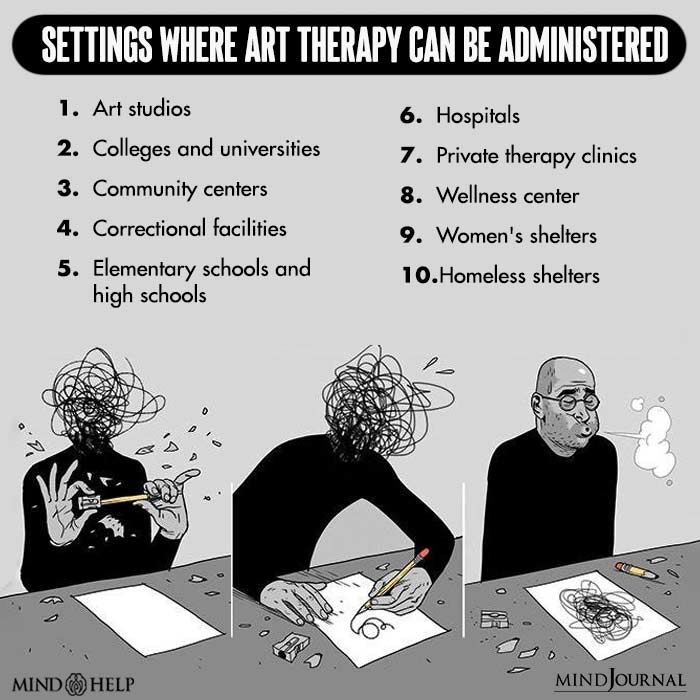
How to Practice Art Therapy in a Home Setting?
Consider the following steps 14 Vaartio-Rajalin, H., Santamäki-Fischer, R., Jokisalo, P., & Fagerström, L. (2020). Art making and expressive art therapy in adult health and nursing care: A scoping review. International journal of nursing sciences, 8(1), 102–119. https://doi.org/10.1016/j.ijnss.2020.09.011 if you believe that you or someone you love would be benefited from art therapy:
- Consider working with a licensed art therapist or seeking guidance from online resources to enhance your art therapy exercises
- Experiment with different art materials such as paper, fabric, or photographs to see which ones you most enjoy working with
- Set aside a specific time each day or week for your art therapy practice
- Create a comfortable and well-lit space that is dedicated to your art therapy practice
- Make sure you have all the necessary art supplies, such as paper, paint, markers, and brushes, within reach
- Select a theme or focus for your art therapy session, like emotions or specific issues, to guide your creative process and provide direction
- Allow yourself to create freely without any judgment or self-criticism
Takeaway
Art therapy can promote relaxation, reduce stress, enhance communication and social skills, and develop fine and gross motor skills. Art therapy exercises may not be equally appealing to everyone. Still, these can be practiced at home with a focus on choosing a theme or issue to guide the creative process and allowing oneself to create without judgment or self-criticism.
At A Glance
- Art therapy is a form of therapy that utilizes the creative process of making art to improve mental health and well-being.
- Different types of art therapy include drawing, sculpture, collage, or painting to express themselves.
- It can be used to treat a variety of conditions, including anxiety, depression, trauma, and stress-related disorders.
- Art therapy can be conducted in individual or group settings.
- Promoting relaxation, stress reduction, and enhancing communication can be considered the benefits of art therapy.
- Art therapy may not be as effective as other forms of therapy, and may not offer immediate relief to those in urgent need.
- It can be practiced at home by choosing a theme or focus, giving oneself permission to create without judgment or self-criticism, and utilizing materials on hand.
Frequently Asked Questions (FAQs)
1. Do I need art training or experience to participate in art therapy?
No, artistic skill is not necessary for art therapy to be effective. It is more about the process of creating and expressing oneself rather than the final product.
2. How often should you do art therapy?
The frequency of art therapy sessions can vary depending on individual needs and goals. In some cases, art therapy may be recommended as a weekly or bi-weekly session, while in other cases, it may be recommended less frequently. It’s best to consult with a qualified art therapist to determine the appropriate frequency and duration of art therapy sessions based on your specific needs and goals.
3. What are the 3 uses of art therapy?
Art therapy utilizes the creation or appreciation of art to help individuals: 1. explore emotions and develop self-awareness 2. cope with stress 3. boost self-esteem and improve social skills.
References:
- 1Iguina, M. M., & Sanaz Kashan. (2019, November 6). Art Therapy. Nih.gov; StatPearls Publishing. Available from: https://www.ncbi.nlm.nih.gov/books/NBK549771/
- 2Millard, E., Medlicott, E., Cardona, J., Priebe, S., & Carr, C. (2021). Preferences for group arts therapies: a cross-sectional survey of mental health patients and the general population. BMJ open, 11(8), e051173. https://doi.org/10.1136/bmjopen-2021-051173
- 3Günter M. (1990). Gestaltungstherapie in der psychiatrischen Klinik. Eine historische Analyse der Entstehung von Malateliers [Art therapy in the psychiatric clinic. A historical analysis of the development of art studios]. Psychiatrische Praxis, 17(5), 163–171.
- 4Joschko, R., Roll, S., Willich, S. N., & Berghöfer, A. (2022). The effect of active visual art therapy on health outcomes: protocol of a systematic review of randomised controlled trials. Systematic reviews, 11(1), 96. https://doi.org/10.1186/s13643-022-01976-7
- 5Bitonte, R. A., & De Santo, M. (2014). Art Therapy: An Underutilized, yet Effective Tool. Mental illness, 6(1), 5354. https://doi.org/10.4081/mi.2014.5354
- 6Hu, J., Zhang, J., Hu, L., Yu, H., & Xu, J. (2021). Art Therapy: A Complementary Treatment for Mental Disorders. Frontiers in psychology, 12, 686005. https://doi.org/10.3389/fpsyg.2021.686005
- 7Maltz, B., Hoyt, T., Uomoto, J., & Herodes, M. (2020). A case analysis of service-member trauma processing related to art therapy within a military-intensive outpatient program. Journal of clinical psychology, 76(9), 1575–1590. https://doi.org/10.1002/jclp.22929
- 8Aletraris, L., Paino, M., Edmond, M. B., Roman, P. M., & Bride, B. E. (2014). The use of art and music therapy in substance abuse treatment programs. Journal of addictions nursing, 25(4), 190–196. https://doi.org/10.1097/JAN.0000000000000048
- 9Luo, X., Zhang, Z., Zheng, Z., Ye, Q., Wang, J., Wu, Q., & Huang, G. (2022). Art therapy as an adjuvant treatment for schizophrenia: A protocol for an updated systematic review and subgroup meta-analysis of randomized clinical trials following the PRISMA guidelines. Medicine, 101(40), e30935. https://doi.org/10.1097/MD.0000000000030935
- 10Pardee, C. (n.d.). Art Therapy and Bipolar Disorder. Www.academia.edu. Retrieved May 3, 2023, from https://www.academia.edu/13387965/Art_Therapy_and_Bipolar_Disorder
- 11Shukla, A., Choudhari, S. G., Gaidhane, A. M., & Quazi Syed, Z. (2022). Role of Art Therapy in the Promotion of Mental Health: A Critical Review. Cureus, 14(8), e28026. https://doi.org/10.7759/cureus.28026
- 12Uttley, L., Scope, A., Stevenson, M., Rawdin, A., Elizabeth Taylor Buck, Anthea Sutton, Stevens, J., Kaltenthaler, E., Dent-Brown, K., & Wood, C. (2015, March). The acceptability and relative benefits and potential harms of art therapy: qualitative systematic review. Nih.gov; NIHR Journals Library. Available from: https://www.ncbi.nlm.nih.gov/books/NBK279642/
- 13Cook, S. C., Schwartz, A. C., & Kaslow, N. J. (2017). Evidence-Based Psychotherapy: Advantages and Challenges. Neurotherapeutics : the journal of the American Society for Experimental NeuroTherapeutics, 14(3), 537–545. https://doi.org/10.1007/s13311-017-0549-4
- 14Vaartio-Rajalin, H., Santamäki-Fischer, R., Jokisalo, P., & Fagerström, L. (2020). Art making and expressive art therapy in adult health and nursing care: A scoping review. International journal of nursing sciences, 8(1), 102–119. https://doi.org/10.1016/j.ijnss.2020.09.011
